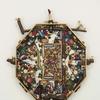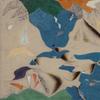Jazz Age Artists flocked to Santa Barbara
- July 23, 2009 09:39
Before Hollywood claimed the role of movie-making capital, Santa Barbara, California, ninety miles north of Los Angeles, was the epicenter of the burgeoning film industry.
Surrounded by picturesque mountains, a sparkling ocean, and lovely streets lined with various revival-style architecture, this small city provided the ideal backdrop for nearly 1,200 silent films made by Flying A Studios before the production company moved to Los Angeles.
Around this time, known as the Jazz Age period between 1918 and 1930, leading artists, architects, landscape designers, and craftsmen flocked to "America's Riviera" to paint and create alongside the filmmakers.
Designer Louis Comfort Tiffany, architect George Washington Smith, and (posthumously) the Herter Brothers were among the renowned creators of the era who informed Santa Barbara homes, institutions and gardens with an enduring sense of style. (Although ornate Herter Bros. furniture and interior design is mostly associated with Gilded Age New York, by the 1920s, Christian Herter's (died 1883) artistic wife, Adele, and their son, Albert, famously carried on his vision in their Moorish-style Santa Barbara mansion, El Mirasol.)
Away from the avant-garde art scenes in Europe and New York, the quiet resorts, beaches and hillsides of Santa Barbara offered a refuge for painting landscapes en plein air. On the market today is a sampling of Santa Barbara-made works of art from this artistic period:
Colin Campbell Cooper (American, 1856-1937), "Refugio at Sunset," gouache on paper, 4.75 by 7 inches. Dated "October 6, 1925." For sale at Sullivan Goss Gallery in Santa Barbara. The gallery represents the artist's estate and offers many fine examples of Cooper's work, including studies and major works in oil.
Cooper, a major American Impressionist, moved to Santa Barbara in 1921 after his wife, the artist Emma Lampert Cooper, had died. Well-versed in the realist tradition by his studies with Thomas Eakins at the Pennsylvnia Academy of Art and at the academies Julian, Vitti, and Decluse in Paris, Cooper forged his own signature style of impressionism defined by a vivid palette and energetic brushwork.
Lockwood deForest (American, 1850-1932), "A California Sunset, Santa Barbara, California," Signed and dated "1923," Oil on canvas, 24 by 34 inches. For sale at Baltimore-based GHR Fine Art. Sullivan Goss Gallery also carries a fine selection of deForest's work from the artist's estate.
A design collaborator with Louis Comfort Tiffany, gifted Lockwood deForest was a landscape, building and furniture designer; an importer of exotic furnishings; and a noted painter who carried the Hudson River School landscape tradition into the looser brushstrokes characterizing California plein air painting.
William Woodward (American/New Orleans, 1859-1939) "Sunlit View of the Mission Santa Barbara, California", 1926, oil on canvas board, signed and dated lower left "W. Woodward '26", frame retains label "Francis Hendricks Co., Inc., Syracuse, New York", 13-3/4" x 19-7/8". Presented in a giltwood frame. Auctioned in New Orleans on July 26th, lot 999, at New Orleans Auction, St. Charles Gallery, Inc. Known largely for his impressionist paintings of the New Orleans French Quarter, William Woodward was an etcher, architect, teacher, and painter who traveled widely on sketching trips.
Cooper, deForest, and Woodward, second-generation impressionists, represent only a small sampling of artists active in Santa Barbara during the post-World War I era











__2016_100x100_c.jpg)








![Peter Paul Rubens (Flemish, 1577–1640), After Titian (Tiziano Vecelli) (Italian [Venetian], c. 1488–1576), Rape of Europa, 1628–29. Oil on canvas, 71 7/8 x 79 3/8 in. Peter Paul Rubens (Flemish, 1577–1640), After Titian (Tiziano Vecelli) (Italian [Venetian], c. 1488–1576), Rape of Europa, 1628–29. Oil on canvas, 71 7/8 x 79 3/8 in.](/images/c/e2/2e/Jan20_Rape_of_Europa100x100_c.jpg)
